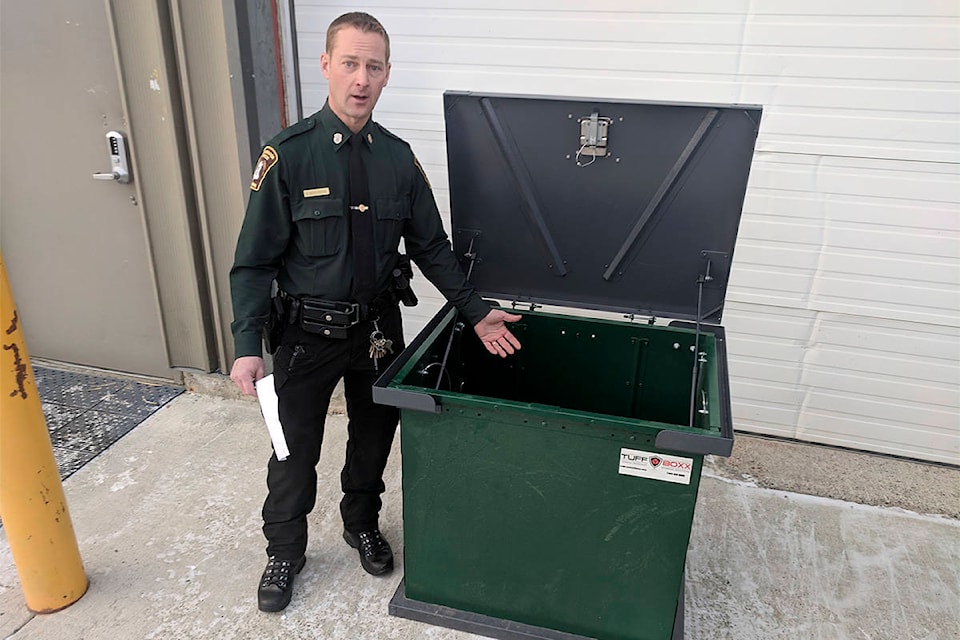A pilot project aimed at keeping bears out of household waste could be another year away.
Geoff Quinsey, manager of water and waste services for the City of Whitehorse, outlined the city’s work to keep bears from getting into garbage around town at council’s May 13 meeting.
Among the initiatives is a potential pilot project that would deliver between 50 and 100 bear-resistant waste carts in 2020 to Whitehorse homes on the city’s waste collection system.
Before that can come forward, Quinsey said, a recommended cart has to be found.
He said there is a possible cart option being looked at, but it still has to get the proper certification to be deemed bear-resistant. That testing is anticipated to happen this summer.
“The grizzlies who do the testing have a date with that cart,” he said, adding WildSafeBC is coordinating the testing for that specific cart.
Should that certification be granted, the purchase for the carts for the pilot project could come forward as part of the 2020 capital budget.
With a number of suppliers knowing Whitehorse is considering bear-resistant carts, there’s a few in town that have been looked at by various parties including Environment Yukon.
Issues around freezing latches, difficulty in moving the carts and other factors are considered with each cart.
The city has also looked at how other bear-resistant cart options have worked in other cities. There have been issues in some places with the carts not opening when the waste is dumped into the waste truck. At times it has meant the cart being dropped into the collection truck. It then ends up coming into the landfill and having to be taken back to the residence.
“It’s a tremendous drag on operational efficiency,” Quinsey said.
If a pilot project for Whitehorse went ahead next year and the cart proved to work well for the city, that type of cart could be a standard in future purchases.
“New bear-resistant carts could strategically be deployed in those neighbourhoods with higher historic incident rates and hazard rating,” Quinsey said.
He also pointed out the city will need to buy new waste carts next year as part of the standard service and that purchase will likely be for the same types of non-bear resistant carts used now until the results of any pilot project are determined.
Meanwhile, those living in country residential neighbourhoods not on the city’s waste collection system, are also likely to be waiting until next year to find out whether the city will offer any additional options to prevent bears from getting into waste.
Quinsey outlined a potential subsidy that could come from gas tax funding for residents of country residential areas to install bear-resistant enclosures.
They could be similar to the bins four First Nations have installed at locations in their communities.
Selkirk First Nation, Little Salmon Carmacks First Nation, Kwanlin Dün First Nation and the Ta’an Kwäch’än Council have bins in their communities this year after working with Environment Yukon in 2018 to determine which type could work best.
Environment Yukon spokesperson Roxanne Stasyszyn said in an interview May 16 the First Nations initiated the purchase, with conservation officers assisting with information and distribution of the bins.
The department is working with the First Nations to collect information on how well the bins work in their first year.
City of Whitehorse staff have also considered the possibility of a central collection system with large bear-resistant bins or small fenced-in transfer stations in country residential neighborhoods, but it is not being pursued.
“These are not recommended because they are considered likely to attract illegal dumping, compromise diversion of materials from the waste management facility and carry high service costs that would have to be passed on to customers,” Quinsey stated in his report, pointing to issues that have arisen in Canmore, Alta. with the Haul-All bins.
As work continues on finding options for Whitehorse, Coun. Laura Cabott suggested enforcing existing bylaws, which prohibit setting out waste in a way that could attract wildlife. That can come with a $200 fine.
City manager Linda Rapp said administration would report back to council on potential options for greater enforcement.
In the meantime, officials are also continuing efforts to educate the public with an info graphic made in partnership with WildWise Yukon set to make its way to Whitehorse homes in the near future.
It details figures showing an average of 20 bear incident reports in Whitehorse each year. Of those 14 happen in areas not on the city’s waste collection program and six happen in the more urban areas of town where garbage is collected by the city. The information also highlights what residents can do to reduce the risk of bear incidents through efforts like keeping attractants out of sight, washing waste carts to reduce odours and putting waste out as close to collection time as possible.
WildWise Yukon executive director Heather Ashthorn stressed the importance trying new initiatives and working towards solutions to address bear-human conflicts, including pursuing bear resistant carts for curbside collection.
With files from Jackie Hong
Contact Stephanie Waddell at stephanie.waddell@yukon-news.com
